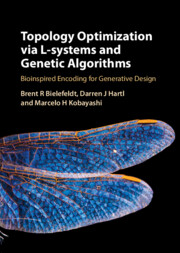 Topology Optimization via L-Systems and Genetic Algorithms
Topology Optimization via L-Systems and Genetic Algorithms Book contents
- Frontmatter
- Contents
- 1 Introduction
- 2 Review of Topology Optimization Methods
- 3 Introduction to L-systems and Turtle Graphics Interpretation
- 4 Spatial Interpretation for the Development of Reconfigurable Structures (SPIDRS)
- 5 Arrangement L-system Interpretation
- 6 Multiphysical Applications
- Appendix A Vector Spaces
- Appendix B Classical Methods in Optimization
- Appendix C Classical Simplex-Based Approach to Ground Structure Optimization
- Appendix D Increasing Structural/Networking Feasibility in Turtle-Constructed Graphs
- Appendix E Conversion of Graphs to Volumetric Bodies for Three-Dimensional Analysis and Additive Manufacturing
- References
- Index
3 - Introduction to L-systems and Turtle Graphics Interpretation
Published online by Cambridge University Press: 13 June 2025
- Frontmatter
- Contents
- 1 Introduction
- 2 Review of Topology Optimization Methods
- 3 Introduction to L-systems and Turtle Graphics Interpretation
- 4 Spatial Interpretation for the Development of Reconfigurable Structures (SPIDRS)
- 5 Arrangement L-system Interpretation
- 6 Multiphysical Applications
- Appendix A Vector Spaces
- Appendix B Classical Methods in Optimization
- Appendix C Classical Simplex-Based Approach to Ground Structure Optimization
- Appendix D Increasing Structural/Networking Feasibility in Turtle-Constructed Graphs
- Appendix E Conversion of Graphs to Volumetric Bodies for Three-Dimensional Analysis and Additive Manufacturing
- References
- Index
Summary
To address the need for an inherently multiobjective preliminary design tool, this chapter introduces a heuristic alternative to the conventional topology optimization approaches discussed in the previous chapter. Specifically, a parallel rewriting system known as a Lindenmayer system (L-system) is used to encode a limited number of design variables into a string of characters which, when interpreted using a deterministic algorithm, governs the development of a topology. The general formulation of L-systems is provided before discussing how L-system encodings can be interpreted using a graphical method known as turtle graphics. Turtle graphics constructs continuous, straight line segments by tracking the spatial position and orientation of a line-constructing agent, leading to the creation of branched structures that mimic those found in numerous natural systems. The performance of the proposed method is then assessed using simple, well-known topology optimization problems and comparisons to mathematically known optimal or ideal solutions as well as those generated using conventional topology optimization methodologies.
Keywords
Information
- Type
- Chapter
- Information
- Topology Optimization via L-Systems and Genetic AlgorithmsBioinspired Encoding for Generative Design, pp. 86 - 111Publisher: Cambridge University PressPrint publication year: 2025